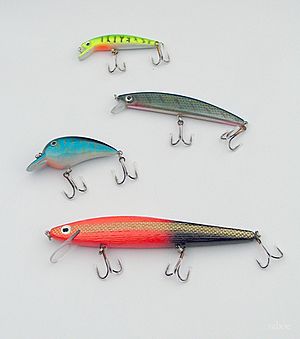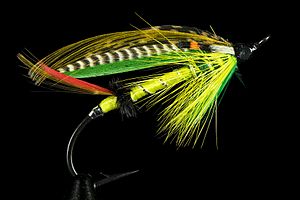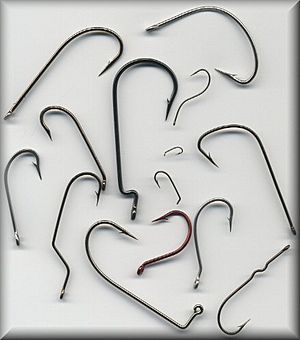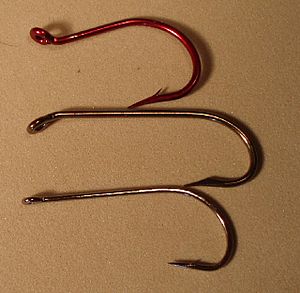Fishing hook facts for kids
A fishing hook is a special tool used to catch fish. It's a type of hook that helps anglers (people who fish) connect their fishing line to the fish. Most fishing hooks have a very sharp point that sticks into the fish when it bites. There are many different kinds of hooks, and they are chosen based on the type of fish you want to catch and how strong the hook needs to be.
Contents
Types of Fishing Hooks
There are many different types of fishing hooks, each designed for a specific purpose. The main types are:
- Bait hooks: Used with natural bait like worms or minnows.
- Fly hooks: Used for artificial flies that imitate insects.
- Lure hooks: Used on artificial lures that look like small fish or other prey.
Hook types vary in their shape, the materials they are made from, their points and barbs, and how their eye is designed. Each part of a hook is carefully made to work best for its job. For example, a hook for a light fly might be very thin and light. A hook for live bait might also be thin to avoid hurting the bait too much. Many things are considered when designing a hook, like how strong it is, if it will rust, and how well it can hook a fish.
Hooks come in many sizes, from very tiny ones (size 32) to very large ones (size 20/0).
Hook Shapes and Names
Just like there are many kinds of fish, there are many shapes and names for hooks! Some hooks have old, traditional names like "Aberdeen" or "Limerick." Others are named after their general use or their features.
The main part of the hook, called the shank, can be straight or have different curves, bends, or twists. These shapes can help the hook go into the fish better, make an artificial fly look more real, or hold bait more securely. Some hooks have special cuts on their shanks to help hold dead bait. Jig hooks are made so that a lead weight can be molded onto them. Hooks can also be described by how long their shank is (standard, extra long, short) or how thick the wire is (fine, heavy).
Single, Double, and Triple Hooks


Hooks can have one, two, or three points:
- Single hooks: These are the most common, with one eye, one shank, and one point.
- Double hooks: These have one eye but two shanks and two points. They are made from a single piece of wire. Double hooks are sometimes used on artificial lures and for traditional Atlantic Salmon flies.
- Triple hooks: These have one eye and three shanks with three points spread out evenly. Triple hooks are often used on many types of artificial lures and for different bait fishing methods.
Bait Hook Shapes
Some common names for bait hook shapes include Salmon Egg, Beak, O'Shaughnessy, Baitholder, Shark Hook, Aberdeen, Carlisle, Carp Hook, Tuna Circle, Offset Worm, Circle Hook, and Octopus Hook.
Fly Hook Shapes
Fly hook shapes include Sproat, Sneck, Limerick, Kendal, Viking, and Keel.
Points and Barbs
The hook point is very important because it's the part that goes into the fish's mouth. How sharp and shaped the point is affects how easily it can get into the fish. The barb is a small piece of metal behind the point that helps keep the hook in place once the fish is caught. Some hooks are sharpened by machines, while others are sharpened with chemicals.
Some hooks are barbless. This means they don't have a barb. Barbless hooks are often used when anglers want to release fish easily and safely, causing less harm to the fish. Hook points can also be straight or slightly bent to the left (kirbed) or right (reversed).
It's important to be careful when handling hooks because they are very sharp. Always handle them with care to avoid accidentally hooking yourself.
Hook Point Types
Common names for hook points include needle point, hollow, spear, beak, and knife edge.
Eyes
The eye of a hook is where you tie your fishing line. The design of the hook's eye is important for strength, weight, and how the hook looks in the water.
There are several types of hook eyes:
- Ring or ball eye: A simple, closed loop.
- Brazed eye: The eye is fully closed and very strong.
- Tapered eye: Thinner to reduce weight.
- Looped eye: A traditional style, especially for Atlantic Salmon flies.
- Spade end: This type has no eye at all, but a flattened area where the line is tied using a special snelling method.
Hook eyes can also be positioned in three ways on the shank: pointing up, pointing down, or straight.
Size
There isn't one worldwide standard for hook sizes, so sizes can be a little different between different manufacturers. However, within one company's hooks, the sizes will be consistent.
Hook sizes usually follow a numbering system. A size 1 hook is in the middle of the range.
- Smaller hooks have larger whole numbers (like 2, 3, 4, up to 32, which is the smallest).
- Larger hooks have numbers followed by a slash and a zero (like 1/0 (pronounced "one aught"), 2/0, 3/0, up to 20/0, which is the largest).
These numbers show the relative size, usually related to the "gap" (the distance from the hook's point to its shank).
Gallery
Images for kids
-
Native American shell fish hook from California. Auckland Museum
-
The Palomar knot, a commonly used knot to attach a monofilament line to the hook
See also
 In Spanish: Anzuelo para niños
In Spanish: Anzuelo para niños














